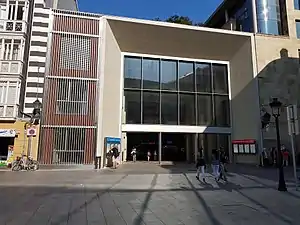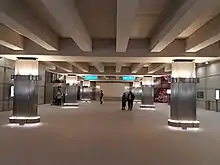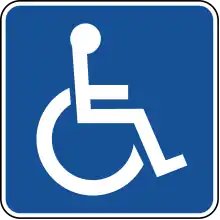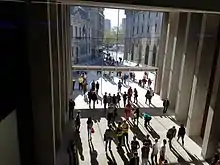Zazpikaleak/Casco Viejo station
Zazpikaleak/Casco Viejo (Basque for Seven Streets and Spanish for Old Town) is a railway station in Bilbao, Basque Country (Spain). It is located in the historical neighbourhood of Casco Viejo, in the district of Ibaiondo. It connects the rapid transit network of Metro Bilbao with the commuter rail services of Euskotren Trena. It is the main hub of railway connection between the metropolitan underground network and the railway services to Eibar, Gernika, Bermeo and San Sebastián as well as the Txorierri valley. In its current form, the station opened on 8 April 2017.
Zazpikaleak/Casco Viejo | |
|---|---|
| Rapid transit and commuter rail | |
 Station's main entrance | |
| Location | 3, San Nicolás Square 48005 Bilbao Spain |
| Coordinates | 43°15′36″N 2°55′19″W |
| Owned by | Consortium of Biscayan Transport (CTB) and Metro Bilbao S.A. |
| Line(s) | Metro Bilbao: Euskotren Trena: |
| Platforms | 4 side platforms |
| Tracks | 4 |
| Connections | Bus, tramway |
| Construction | |
| Structure type | Underground, elevated station |
| Platform levels | 2 |
| Parking | No |
| Disabled access | Yes |
| Other information | |
| Fare zone | Zone 1 |
| History | |
| Opened | 1 July 1904 |
| Closed | 15 May 2010 |
| Rebuilt | 8 April 2017 |
History
The original station, named Bilbao-Aduana, was opened on 1 July 1904 as the terminus station of the narrow-gauge Bilbao-Plencia railway, an expansion of the original Bilbao-Las Arenas line, which opened in 1887. The Bilbao-Aduana station replaced the older but less centric Bilbao-San Agustín station.[1] The station was located on the former location of a customs building for the city's portuary facilities, hence named Aduana (Spanish for customs office). Bilbao-Aduana was an open-air station fitted between a hillside and the street. The trains emerged from a tunnel, named Esperanza tunnel due to being close to the street with the same name, before reaching the station platforms.[2] The station immediately after was Matico, an open-air station located in the neighbourhood of Matiko, and reached after traversing the Esperanza and Gas tunnels.
The station was operated by the Company of the Railways from Bilbao to Las Arenas and Plencia until 1947, after which it was merged with other narrow-gauge lines across the Bilbao metropolitan area to form Ferrocarriles y Transportes Suburbanos de Bilbao S.A. (Railways and Suburban Transport of Bilbao), shortened FTS and the first precedent of today's Metro Bilbao. During this time the station became the main hub for the urban railway transit within the city of Bilbao and its metropolitan area, serving the lines to Getxo and Plentzia, as well as being in close proximity to other important stations like Bilbao-Abando across the river and Bilbao-Calzadas, also part of the FTS network and with trains serving the Txorierri valley, just a few blocks away. During this time the name of the station was changed to Bilbao-San Nicolás and it also held the central offices for FTS.[3] The name came from the neighbouring San Nicolás church.
In 1977 the FTS network was transferred to the public company FEVE and in 1982 to the recently created Basque Railways. After the transfer, it was announced that parts of the Bilbao-Plencia line would be renewed and transformed into the first line of Metro Bilbao (specifically the section between Deusto and Plentzia), and thus management of the station facilities was transferred to CTB (Consortium for Biscayan Transport) in 1995.[3] As part of the renovation plans, the original station was demolished and replaced with a more modern infrastructure that included a new underground station for Metro Bilbao and overground open-air platforms for the existing services between Deusto and Bilbao-San Nicolás, which remained separate from the Metro Bilbao network. In 1996 a new tunnel was constructed linking Bilbao-San Nicolás with the former station of Bilbao-Calzadas, thus connecting with the Txorierri line. The new line was established as Deusto-Lezama and resulted from the merging of the section of the Bilbao-Plencia railway that was not integrated into Metro Bilbao (from Deusto to Bilbao-San Nicolás) and the line between Bilbao-Calzadas and Lezama. The new line was operated by Euskotren.[3] The station was then once again renamed from Bilbao-San Nicolás to Zazpikaleak (Basque for "seven streets", the historical name of the old city), while the underground station was named Casco Viejo and was operated by Metro Bilbao.
In 2007 it was made public the project for the line 3 of Metro Bilbao which would link Etxebarri to Bilbao via the Otxarkoaga-Txurdinaga district, ultimately connecting with the old town and the Matiko area. The project involved a new connection station in the Zazpikaleak station, as well as a renovation of the section between Zazpikaleak and the Zumalakarregi and Matiko stations that until then were part of the Deusto-Lezama line. In 2009 the Basque Government presented the project for the new railway connection with Bilbao Airport, which included a connection from Matiko to the Airport via Sondika.[4] This meant the integration of the Deusto-Lezama line into two news lines, which would be operated by Euskotren Trena instead of Metro Bilbao S.A. as the other metro lines.[4] The new line 3 would connect in Etxebarri with the general Euskotren Trena railway line to Bermeo and San Sebastián, which would allow to divert trains to the new Zazpikaleak station, integrating the Euskotren services in a single station.
The section between Deusto and Zazpikaleak was closed down to railway traffic on 15 May 2010 once construction for the new line began. In June 2015 the Zazpikaleak station was closed down to be demolished to build a new one in its place.[5] The new station was opened on 8 April 2017 with the new name Zazpikaleak/Casco Viejo.
Station layout

The original station built in 1904 was an open-air station with two elevated side platforms located behind the station's building. On the ground floor there were located ticket offices and waiting rooms, as well as the access to the platforms. The rest of the building included offices for the railway administration as well as apartments for its workers.[6] After the first renovation made in the 1990s, the renovated building included a main hall with separate access to the Euskotren platforms, which were located on their original situation elevated behind the station, and the Metro Bilbao platforms, which were underground and followed the same cavern-like architecture as those in the rest of the network, designed by Norman Foster.
The current station has a large common hall with ticket and customer care offices, with tunnels connecting to the respective Euskotren Trena and Metro Bilbao platforms.
Access
 3, San Nicolás Square (Lines 3, E1 and E3 of Euskotren Trena)
3, San Nicolás Square (Lines 3, E1 and E3 of Euskotren Trena) 3, San Nicolás Square (Lines 1 and 2 of Metro Bilbao, San Nicolás - Euskotren exit)
3, San Nicolás Square (Lines 1 and 2 of Metro Bilbao, San Nicolás - Euskotren exit)
 1, Miguel de Unamuno Plaza (Unamuno exit, lines 1 and 2 only)
1, Miguel de Unamuno Plaza (Unamuno exit, lines 1 and 2 only)
 28, Mallona (Begoña exit, lines 1 and 2 only)
28, Mallona (Begoña exit, lines 1 and 2 only)
Services
Rail services
When the station first opened in 1904 as Bilbao-Aduana, it served as the terminus station of the Bilbao-Plencia railway, which joined the city with other municipalities within the Greater Bilbao like Leioa, Getxo and Plentzia. After 1996 it was part of the commuter-rail network operated by Euskotren from Deusto to Lezama, with services to Derio, Sondika and Zamudio. Since 2019 it serves as a stop for all commuter rail services offered by Euskotren Trena in Biscay.
| Preceding station | Euskotren Trena | Following station | ||
|---|---|---|---|---|
| Uribarri toward Matiko |
Line E1 | Zurbaranbarri toward Elgoibar or Donostia-Amara | ||
| Uribarri toward Matiko |
Line 1D | Zurbaranbarri toward Durango or Zaldibar | ||
| Uribarri toward Lezama |
Line E3 | Zurbaranbarri toward Kukullaga | ||
| Uribarri toward Matiko |
Line E4 | Zurbaranbarri toward Bermeo |
Metro services
The station served as the southern terminus for Metro Bilbao's line 1 from its opening in 1995 until the opening of Bolueta station in 1997. Currently it serves as a connection hub between the three lines of the network.
| Preceding station | Metro Bilbao | Following station | ||
|---|---|---|---|---|
| Line 1 | toward Etxebarri |
|||
toward Kabiezes | Line 2 | toward Basauri |
||
toward Matiko | Line 3 | toward Kukullaga |
Bus and tramway
The station is served by the following local Bilbobus services. A 'G' in the line name denotes a Gautxori night line service.
- A2 Solokoetxe - Biribila Plaza
- A5 Prim - Biribila Plaza
- 11 Deusto - Atxuri
- 22 Sarrikue - Atxuri
- 62 San Mames - Arabella
- G4 La Peña - Biribila Plaza
- G8 Arangoiti - Biribila Plaza
The station is also served by the following regional Bizkaibus services, running to other municipalities within the Bilbao metropolitan area or elsewhere in Biscay.
- A3521 Bilbao - Hosp. Sta. Marina
- A3631 Bilbao - Galdakao - Larrabetzu
- A3632 Bilbao - Basauri - San Miguel
- A3911 Elorrio - Durango - Hosp. Galdakao - Bilbao
- A3912 Eibar - Lemoa - Hosp. Galdakao - Bilbao
- A3917 Zeanuri - Hosp. Galdakao - Bilbao
- A3925 Ubide - Otxandio - Lemoa - Bilbao
There is a 300 m walking distance between the Zazpikaleak/Casco Viejo station and the Arriaga stop of Bilbao's tramway. The tramway has regular services to Bilbao-Atxuri station, the Abando district, the Guggenheim Museum area and the San Mamés Stadium, between others.
Gallery
 Station's entrance on opening day
Station's entrance on opening day Main hall on opening day
Main hall on opening day Euskotren Trena and Line 3 platforms
Euskotren Trena and Line 3 platforms.jpg.webp) Platforms for lines 1 and 2
Platforms for lines 1 and 2
See also
References
- Alonso, Alberto G. (23 April 2017). "When there were seven railway stations in the city". Deia. Bilbao. Retrieved 28 September 2018.
- "Noticias Bilbaínas". El Noticiero Bilbaíno. Bilbao. 1 July 1904. Retrieved 28 September 2018.
- Peris Torner, Juan (9 May 2012). "Ferrocarriles y Transportes Suburbanos de Bilbao S.A." Spanish Railways. Retrieved 28 September 2018.
- Gude, Erlantz (29 July 2007). "Contract awarded for the Artxanda tunnel that will connect Bilbao with the airport". El Correo. Vitoria-Gasteiz. Retrieved 28 September 2018.
- "Euskotren says goodbye to the old station tomorrow". Deia. Bilbao. 31 May 2015. Archived from the original on 23 June 2015. Retrieved 28 September 2018.
- Olaizola Elordi, Juanjo (1 June 2015). "Hasta la vista Aduana". Historias del Tren. Retrieved 28 September 2018.